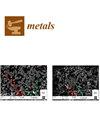原子排序对钯银合金相稳定性和弹性性能的影响
IF 2.5
3区 材料科学
Q3 MATERIALS SCIENCE, MULTIDISCIPLINARY
引用次数: 0
摘要
钯(Pd)及其合金以其良好的耐腐蚀性、催化效率和氢亲和性而闻名,在各种工业应用中得到广泛应用。然而,由于纯钯易发生氢脆,因此有必要采用钯银系统等合金策略。本研究通过第一性原理计算研究了有序化对 Pd-Ag 合金的相稳定性和弹性性能的影响。我们利用特殊准随机结构 (SQS) 探索了一系列有序相结构和随机固溶体,评估了它们的热力学稳定性和弹性特性。我们的研究结果表明,可能存在稳定的有序 L12 Pd3Ag 和 PdAg3 以及 L11 PdAg 相,而这些相被认为只存在于铜铂合金中。对弹性常数和各向异性指数的分析强调了随机固溶相和有序相之间机械响应的一些明显的方向依赖性。这表明有序相不仅在热力学和机械性能上比固溶相更稳定,而且各向异性指数也有所下降。这些结果加深了对钯银合金原子行为的理解,并为设计多相钯银合金以改善其机械性能提供了启示。本文章由计算机程序翻译,如有差异,请以英文原文为准。
Effect of Atomic Ordering on Phase Stability and Elastic Properties of Pd-Ag Alloys
Palladium (Pd) and its alloys, renowned for their good corrosion resistance, catalytic efficiency, and hydrogen affinity, find extensive use in various industrial applications. However, the susceptibility of pure Pd to hydrogen embrittlement necessitates alloying strategies such as Pd-Ag systems. This study investigates the impact of the ordering on the phase stability and elastic properties of Pd-Ag alloys through first-principles calculations. We explore a series of ordered phase structures alongside random solid solutions using Special Quasirandom Structures (SQSs), evaluating their thermodynamic stability and elastic properties. Our findings indicate the possible existence of stable ordered L12 Pd3Ag and PdAg3 and L11 PdAg phases, which are thought to exist only in Cu-Pt alloys. An analysis of the elastic constants and anisotropy indices underscores some pronounced directional dependencies in the mechanical responses between the random solid-solution and ordered phases. This suggests that the ordered phases not only are thermodynamically and mechanically more stable than solid-solution phases, but also display a decrease in anisotropy indices. The results provide a deeper understanding of the atomic behavior of Pd-Ag alloys, and shed light on the design of multiphase Pd-Ag alloys to improve their mechanical properties.
求助全文
通过发布文献求助,成功后即可免费获取论文全文。
去求助
来源期刊

Metals
MATERIALS SCIENCE, MULTIDISCIPLINARY-METALLURGY & METALLURGICAL ENGINEERING
CiteScore
4.90
自引率
13.80%
发文量
1832
审稿时长
1.5 months
期刊介绍:
Metals (ISSN 2075-4701) is an open access journal of related scientific research and technology development. It publishes reviews, regular research papers (articles) and short communications. Our aim is to encourage scientists to publish their experimental and theoretical results in as much detail as possible. Therefore, there is no restriction on the length of the papers. The full experimental details must be provided so that the results can be reproduced. Metals provides a forum for publishing papers which advance the in-depth understanding of the relationship between the structure, the properties or the functions of all kinds of metals.
 求助内容:
求助内容: 应助结果提醒方式:
应助结果提醒方式:


